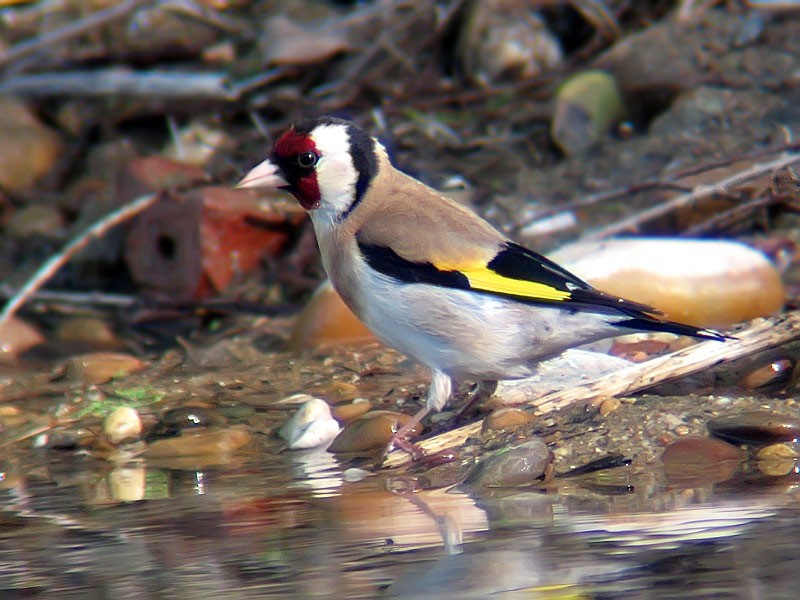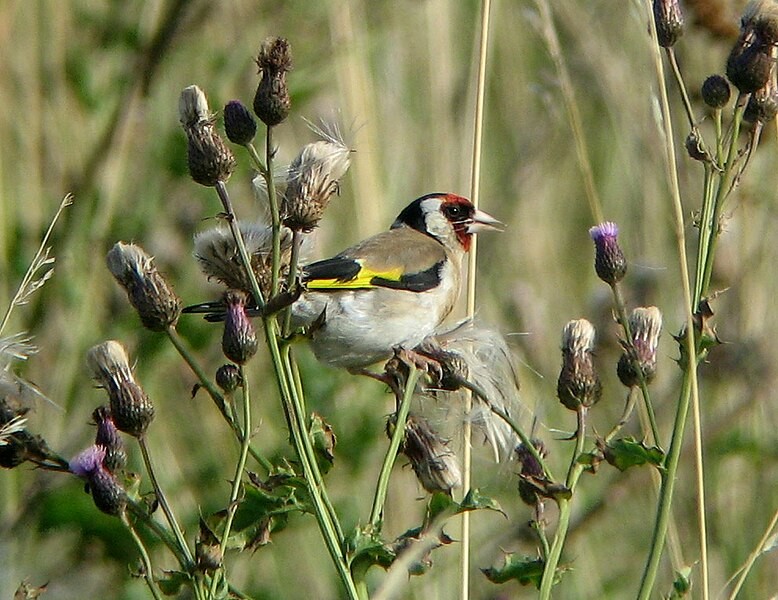Are you wondering, “Can You Have A Goldfinch As A Pet?” At PETS.EDU.VN, we’re here to guide you through the fascinating world of keeping these vibrant birds. Discover the joys and responsibilities of caring for a goldfinch, and learn if this delightful creature is the right companion for you. Dive in to learn about goldfinch ownership, care needs and legality.
1. Understanding the Allure of Goldfinches as Pets
Goldfinches are undeniably charming birds, celebrated for their stunning plumage and cheerful songs. But before you bring one home, it’s crucial to understand what makes them appealing as pets and whether they align with your lifestyle.
- Visual Appeal: Goldfinches boast vibrant colors, making them a delightful addition to any home. The European Goldfinch, for instance, sports a striking red face, a black and white head, and bright yellow wing bars.
- Melodious Songs: Both male and female goldfinches sing, though the male’s song is typically richer and more complex. Their pleasant vocalizations can create a soothing atmosphere in your home.
- Active and Engaging: Goldfinches are active birds that enjoy flying, foraging, and interacting with their environment. Watching their antics can be quite entertaining.
- Relatively Small Size: Compared to larger parrots, goldfinches are relatively small, making them suitable for smaller living spaces.
- Captive Breeding: European Goldfinches have been bred in captivity for generations, making them better adapted to life as pets than wild-caught birds.
However, owning a goldfinch also comes with responsibilities:
- Specific Dietary Needs: Goldfinches require a specialized diet that includes finch seed mixes, thistle seed, and live insects.
- Spacious Housing: These active birds need ample space to fly and exercise, so a large cage or aviary is essential.
- Social Needs: While they can be kept in pairs or small groups, goldfinches may become territorial during breeding season.
- Commitment: Like any pet, goldfinches require daily care, attention, and a long-term commitment to their well-being.
2. Legality: Can You Legally Keep a Goldfinch?
Before you set your heart on a goldfinch, it’s essential to understand the legal aspects of owning one. The legality of keeping goldfinches as pets varies depending on your location.
- United States:
- American Goldfinches (Carduelis tristis) are protected under the Migratory Bird Treaty Act, making it illegal to keep them as pets without proper permits.
- European Goldfinches (Carduelis carduelis) are not native to North America and are not protected by this act. Therefore, they can be legally kept as pets in most states, but it is important to verify local and state regulations.
- United Kingdom: European Goldfinches are native to the UK and are protected under the Wildlife and Countryside Act 1981. It is illegal to capture or possess wild goldfinches. However, those bred in captivity can be legally kept and sold.
- European Union: The laws regarding goldfinches vary among EU member states. Some countries may have stricter regulations than others.
- Australia: Goldfinches are an introduced species in Australia and are generally allowed to be kept as pets. However, regulations may vary by state or territory.
It is crucial to check with your local wildlife authorities or animal control agencies to determine the specific regulations in your area. Penalties for illegally possessing protected bird species can be severe, including fines and confiscation of the bird. PETS.EDU.VN advises you to be a responsible pet owner and always ensure you are in compliance with the law.
3. Finding a Reputable Goldfinch Breeder
If keeping a goldfinch is legal in your area, the next step is to find a reputable breeder. This is essential to ensure you acquire a healthy, well-socialized bird.
- Research: Look for breeders who specialize in European Goldfinches. Online forums, bird clubs, and avian veterinarians can be good sources of information.
- Visit the Breeder: Whenever possible, visit the breeder’s premises to observe the birds and their living conditions.
- Health and Hygiene: The birds should appear healthy, active, and well-cared for. The facilities should be clean and well-maintained.
- Breeder Knowledge: A reputable breeder should be knowledgeable about goldfinch care, breeding practices, and potential health issues.
- Legitimate Paperwork: Ensure the breeder can provide you with the necessary documentation, such as permits or certificates of origin, to prove the bird was legally bred and acquired.
- Health Guarantee: A good breeder will offer a health guarantee for the bird, providing some assurance that you are getting a healthy animal.
- Questions to Ask:
- How long have you been breeding goldfinches?
- What is the bird’s lineage?
- What is the bird’s diet?
- Has the bird been tested for any diseases?
- Can I see the bird’s parents?
- What is your return policy if the bird becomes ill?
4. Housing Your Goldfinch: Creating the Ideal Habitat
Goldfinches are active birds that require spacious housing to thrive. The size and type of enclosure you provide will significantly impact their well-being.
- Cage Size: A cage for a pair of goldfinches should be at least 30 inches long, 18 inches wide, and 18 inches high. Larger is always better, especially if you plan to keep multiple birds.
- Aviaries: Outdoor aviaries are an excellent option for goldfinches, providing them with ample space to fly and interact with their natural environment.
- Cage Material: Choose a cage made of non-toxic materials, such as stainless steel or powder-coated metal. Avoid cages with lead or zinc, as these can be harmful to birds.
- Bar Spacing: The bar spacing should be no wider than 1/2 inch to prevent the birds from escaping or getting their heads stuck.
- Perches: Provide a variety of perches of different sizes and materials. Natural branches are ideal, as they offer a more comfortable and stimulating surface for the birds’ feet.
- Placement: Place the cage in a well-lit area away from drafts, direct sunlight, and high-traffic areas.
- Enrichment: Add toys and other enrichment items to keep your goldfinches entertained. Swings, ladders, and foraging toys are all good options.
- Hygiene: Clean the cage regularly to prevent the buildup of bacteria and parasites. Remove droppings and uneaten food daily, and thoroughly clean the cage weekly.
5. Nutritional Needs: Feeding Your Goldfinch a Balanced Diet
A proper diet is essential for maintaining your goldfinch’s health and vitality. Goldfinches have specific nutritional needs that must be met to prevent deficiencies and health problems.
- Finch Seed Mix: A high-quality finch seed mix should form the basis of your goldfinch’s diet. Look for mixes that contain a variety of seeds, such as canary seed, millet, and rapeseed.
- Thistle Seed: Thistle seed is a particular favorite of goldfinches and should be offered regularly.
- Nyjer Seed: Nyjer seed, also known as niger seed, is another nutritious seed that goldfinches enjoy.
- Live Insects: Goldfinches are insectivorous birds and require a source of live protein. Mealworms, waxworms, and small crickets can be offered several times a week.
- Egg Food: Egg food is a good source of protein and other nutrients. It can be purchased commercially or made at home.
- Softbill Pellets: Softbill pellets can supplement the diet with essential vitamins and minerals.
- Fresh Produce: Offer small amounts of fresh fruits and vegetables, such as sprouts, carrot tops, spinach, dandelion, and romaine lettuce.
- Grit: Grit is essential for helping goldfinches digest their food. Provide a small dish of grit at all times.
- Cuttlebone: Cuttlebone is a good source of calcium and helps keep the birds’ beaks trimmed.
- Water: Fresh, clean water should always be available. Change the water daily and clean the water dish regularly.
| Food Type | Frequency | Benefits | Considerations |
|---|---|---|---|
| Finch Seed Mix | Daily | Provides basic carbohydrates and fats | Choose a high-quality mix with a variety of seeds. |
| Thistle Seed | Daily | Highly palatable and nutritious | Can be offered in a separate feeder. |
| Nyjer Seed | 2-3 times/week | Rich in oil and energy | Store in a cool, dry place to prevent spoilage. |
| Live Insects | 2-3 times/week | Provides essential protein | Gut-load insects with nutritious food before feeding. |
| Egg Food | 1-2 times/week | Good source of protein and vitamins | Can be mixed with other foods. |
| Softbill Pellets | 1-2 times/week | Provides balanced vitamins and minerals | Choose a reputable brand formulated for finches. |
| Fresh Produce | Daily | Source of vitamins, minerals, and antioxidants | Wash thoroughly and offer in small amounts to prevent spoilage. |
| Grit | Always available | Aids in digestion | Replace regularly. |
| Cuttlebone | Always available | Source of calcium and helps trim the beak | Replace when depleted. |
| Fresh Water | Daily | Essential for hydration | Change daily and clean the water dish regularly. |


6. Health and Wellness: Keeping Your Goldfinch Healthy
Like all pets, goldfinches are susceptible to certain health problems. Regular observation and preventative care are essential for keeping your bird healthy.
- Quarantine: When you first bring your goldfinch home, quarantine it for at least 30 days to ensure it is not carrying any diseases.
- Veterinary Care: Find an avian veterinarian who is experienced in treating finches. Schedule regular checkups to monitor your bird’s health.
- Common Health Issues:
- Air Sac Mites: These microscopic parasites can infest the respiratory system, causing difficulty breathing, sneezing, and wheezing.
- Feather Mites: These external parasites can cause itching, feather loss, and skin irritation.
- Coccidiosis: This parasitic infection affects the intestines, causing diarrhea, weight loss, and dehydration.
- Psittacosis (Chlamydiosis): This bacterial infection can cause respiratory problems, lethargy, and diarrhea.
- Aspergillosis: This fungal infection affects the respiratory system, causing difficulty breathing and lethargy.
- Bacterial Infections: Goldfinches can be susceptible to various bacterial infections, such as E. coli and Salmonella.
- Signs of Illness:
- Lethargy
- Loss of appetite
- Fluffed feathers
- Difficulty breathing
- Sneezing or coughing
- Diarrhea
- Vomiting
- Feather loss
- Swelling or redness
- Preventative Care:
- Provide a clean and hygienic environment.
- Feed a balanced and nutritious diet.
- Provide fresh, clean water daily.
- Monitor your bird’s behavior and appearance for any signs of illness.
- Schedule regular checkups with an avian veterinarian.
If you notice any signs of illness, consult with your avian veterinarian immediately. Early diagnosis and treatment can improve your bird’s chances of recovery.
7. Behavior and Training: Understanding Your Goldfinch’s Needs
Understanding your goldfinch’s behavior is crucial for providing proper care and enrichment. While goldfinches are not typically trained like parrots, you can still interact with them and provide opportunities for mental stimulation.
- Social Behavior: Goldfinches are social birds and enjoy the company of their own kind. They can be kept in pairs or small groups.
- Territoriality: During breeding season, goldfinches may become territorial and aggressive towards other birds.
- Foraging Behavior: Goldfinches spend much of their time foraging for food. Provide them with opportunities to forage by hiding food in toys or scattering it around the cage.
- Bathing: Goldfinches enjoy bathing. Provide them with a shallow dish of water for bathing several times a week.
- Enrichment: Provide a variety of toys and enrichment items to keep your goldfinches entertained. Swings, ladders, and foraging toys are all good options.
- Interaction: While goldfinches are not typically cuddly pets, you can still interact with them by talking to them, offering them treats, and providing them with opportunities to fly and exercise.
- Training: Goldfinches can be trained to perform simple tasks, such as stepping onto a perch or coming when called. Use positive reinforcement techniques, such as rewarding them with treats or praise.
8. Breeding Goldfinches: A Rewarding Experience
Breeding goldfinches can be a rewarding experience, but it requires careful planning and preparation.
- Pairing: Select a healthy and compatible pair of goldfinches.
- Breeding Cage: Provide a spacious breeding cage or aviary with plenty of nesting sites.
- Nesting Material: Offer a variety of nesting materials, such as dried sphagnum moss, grasses, and commercial nesting material.
- Diet: Increase the amount of protein-based foods and fresh produce in the parents’ diet.
- Courtship: Males court prospective mates by swaying back and forth while beating their wings.
- Egg Laying: The female will lay 3-7 eggs, which she will incubate for approximately 14 days.
- Hatching: The chicks will hatch after about 14 days of incubation.
- Feeding Chicks: The parents will feed the chicks a diet of regurgitated insects and seeds.
- Fledging: The chicks will fledge at about 2 weeks of age.
- Independence: The chicks will become fully independent at about 4 weeks of age.
If you are considering breeding goldfinches, it is essential to research the process thoroughly and be prepared to provide the necessary care for the parents and chicks.
9. The Joys and Challenges of Goldfinch Ownership
Owning a goldfinch can be a rewarding experience, but it also comes with its share of challenges.
The Joys:
- Beautiful Appearance: Goldfinches are stunning birds with vibrant colors.
- Pleasant Songs: Their melodious songs can create a soothing atmosphere in your home.
- Active and Engaging: Watching their antics can be quite entertaining.
- Relatively Small Size: They are suitable for smaller living spaces.
- Rewarding Breeding: Breeding goldfinches can be a fulfilling experience.
The Challenges:
- Specific Dietary Needs: They require a specialized diet.
- Spacious Housing: They need ample space to fly and exercise.
- Social Needs: They may become territorial during breeding season.
- Health Issues: They are susceptible to certain health problems.
- Commitment: They require daily care, attention, and a long-term commitment.
Ultimately, the decision of whether or not to keep a goldfinch as a pet is a personal one. Weigh the joys and challenges carefully, and be sure you are prepared to provide the necessary care and attention to these beautiful birds.
10. Finding Additional Resources at PETS.EDU.VN
At PETS.EDU.VN, we understand the complexities of pet ownership and are dedicated to providing you with the resources you need to make informed decisions. Whether you’re considering a goldfinch or already have one, our website offers a wealth of information to help you provide the best possible care.
- Expert Articles: Access in-depth articles on goldfinch care, health, behavior, and breeding. Our articles are written by experienced avian experts and veterinarians.
- Forums: Connect with other goldfinch owners in our online forums. Share your experiences, ask questions, and get advice from fellow enthusiasts.
- Veterinarian Directory: Find a qualified avian veterinarian in your area. Our directory includes reviews and ratings to help you choose the best vet for your goldfinch.
- Product Reviews: Read reviews of the latest goldfinch cages, food, toys, and other supplies. Our reviews are unbiased and based on real-world testing.
- Educational Videos: Watch informative videos on goldfinch care, training, and health. Our videos cover a wide range of topics and are suitable for both beginners and experienced owners.
At PETS.EDU.VN, we are committed to helping you provide the best possible life for your goldfinch. Visit our website today to learn more.
Have you been wondering, “Can you have a goldfinch as a pet?” Do you find yourself struggling to find reliable information on the specific needs of these beautiful birds? Are you concerned about providing the right diet, housing, and healthcare?
Don’t let these challenges prevent you from experiencing the joy of goldfinch ownership. Visit PETS.EDU.VN today to access a wealth of expert articles, connect with other goldfinch owners, and find the resources you need to provide the best possible care for your feathered friend.
Contact us:
- Address: 789 Paw Lane, Petville, CA 91234, United States
- Whatsapp: +1 555-987-6543
- Website: pets.edu.vn
FAQ About Keeping Goldfinches as Pets
1. Are goldfinches good pets for beginners?
Goldfinches are not typically recommended for beginner bird owners. They have specific dietary and housing requirements that can be challenging for those new to bird keeping.
2. How long do goldfinches live in captivity?
With proper care, goldfinches can live for 5-10 years in captivity.
3. Do goldfinches need a lot of attention?
While goldfinches are not as demanding as some other bird species, they still require daily interaction and attention.
4. Can goldfinches be kept alone?
Goldfinches are social birds and prefer to be kept in pairs or small groups.
5. What is the best diet for a goldfinch?
A high-quality finch seed mix, thistle seed, nyjer seed, live insects, egg food, and fresh produce.
6. How much space do goldfinches need?
A cage for a pair of goldfinches should be at least 30 inches long, 18 inches wide, and 18 inches high.
7. Are goldfinches noisy birds?
Goldfinches are not excessively noisy birds, but they do have pleasant vocalizations.
8. Do goldfinches bite?
Goldfinches are not known for biting, but they may nip if they feel threatened.
9. Are goldfinches easy to breed?
Breeding goldfinches can be challenging and requires careful planning and preparation.
10. Where can I find a reputable goldfinch breeder?
Online forums, bird clubs, and avian veterinarians can be good sources of information.
